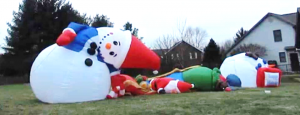This blog is part of the Aging Well series and is written by Robin Gault-Winton, MSW, owner of the organization, Playing at Life.
Play is something done for its own sake. It’s voluntary. It’s pleasurable. It offers a sense of engagement. It takes you out of time; and the act itself is more important than the outcome. -Stuart Brown, MD
With all that is going on in the world – a pandemic, isolation, divisive politics, inequality, and natural disasters – it may seem inappropriate or irresponsible to discuss being playful. In the words of Supertramp (a favorite band of my late teens):
“… they sent me away to teach me how to be sensible, logical, oh responsible, practical. And they showed me a world where I could be so dependable, oh clinical, oh intellectual, cynical.”
As adults we are called upon to protect, challenge, mourn, achieve, and fix things. Play is in opposition to the serious work we must do. Or so we may tell ourselves. But in reality,
“The opposite of play is not work; it is depression.” – Brian Sutton-Smith
Research
Affective neuroscientist Dr. Jaak Panksepp studied the emotional brain and determined that we have emotions located deep within the ancient brainstem - not in our neocortex or advanced brain, as was previously believed. These emotions are related to our basic instincts and motivational drives, like thirst and hunger. One of the seven emotions he identified was play.
We know that play is critical to child development, but Panksepp’s research indicates that play is essential to our survival at any age and its deprivation is unhealthy. Many studies demonstrate play’s positive impacts on adults:
- Fosters innovation and creativity
- Speeds up learning and enhances productivity
- Reduces stress
- Promotes bonding and communication
Engaging in play often leads to laughter, which has been shown to decrease stress and inflammation and potentially improve vascular health. A close relative, humor, is often listed as a desired trait for one’s partner, so being playful may even make us more appealing to others. For all these reasons, I would argue that now is exactly the time to engage your playful nature!
However, despite all the benefits, we don’t always let ourselves be guided by our inherent playfulness like we did as children. In his eBook Playful Path, Bernard de Koven notes that kids must often be told to stop playing, while adults must be reminded to start playing. Consider this your reminder.
Activity
Take a sheet of paper and divide it into three columns titled: childhood, youth, adulthood. For each timeframe, list the ways you played or were playful, keeping Dr. Stuart Brown’s definition from the beginning in mind. If an activity became something you loved for its own sake and you desired to do it, even if someone else originally signed you up for it (e.g., music, sports, etc.), then list it. However, if you did it a lot but only for someone else and did not find joy in it, do not list it. To stimulate your thinking, here’s an example of my list.
| Childhood | Youth | Adulthood |
| · Making paper dolls and their outfits from a Sears catalog
· Creating doll houses using vinyl album covers · Hula hooping · Ballet |
· Ballet
· Creative writing · Drawing · Silk-screening t-shirts · Acting · Coming up with puns · Blowing bubbles inside of bubbles with bubble gum |
· Coming up with puns
· Playing with my kids – tea parties, puzzles, dress up · Dancing · Training others |
Once you finish, spend some time reviewing your responses to see what overall thoughts and feelings come up for you. Do specific ones resonate more for you? Do you notice any themes, such as creativity or competition? Next answer these questions:
- How often do you currently engage in playful activities/approaches? If it is less than weekly (I might even say daily), consider how you can do more. Like exercise, it will be important to make sure you play with some regularity to experience the benefits it provides.
- Consider doing activities you were drawn to as a kid, even if it is in a slightly different way than you did then. As children, we were often connected to our true nature, so engaging in past fun can bring you back to core passions and interests. If you aren’t doing any of them currently, circle one or two from your list to try again and write down your plan for including them into your current routine.
Creating More Play Today
To reap all the benefits we can, we must find ways to approach life more playfully. We need to become more conscious of being playful on a regular basis – not just weekends or while on vacation. As de Koven says,
“The more present you are to playfulness, the more present it is in you.”
As an example, this picture reminds me of one year when I would pass by a house in my neighborhood on my way home from work every day. Each time the inflatable snowman would be in a different odd posture, similar to these guys here. In a Toy Story-inspired way, I would imagine what had occurred during the day that caused his various positions – was he trying to see something across the street, tired from standing so much, or was he playing the cloud-shape game as he lay on his back? Without a playful mindset, people might not notice the snowman at all, or they’d analyze the wind patterns that must have blown it over, or they’d judge the homeowner’s poor staking technique. But because of my playful interpretation, I always arrived home in a happier mood than how I had left the office.
“For kids, play is life. For grown-ups, play is a return to life.” -Bernard de Koven
Dr. René Proyer studies adult playfulness and has identified four primary approaches to play. With his permission, I have created an online format of the short version of his play-type assessment. Visit my website (www.playingatlife.org) and take the quiz for free.
In addition to revisiting the play of your past, it can be helpful to incorporate new types of play in your life. In the table below, I have created a list of possible options based on Dr. Proyer’s four types. Choose an activity that interests you, or come up with your own, and commit to trying it.
|
Playfulness Type
|
Suggested Activities |
|
Other Directed: like to engage with others in a playful, silly, teasing way
|
Contact an old friend and reminisce about the fun things you did together; start a pillow fight; invite your friends to compete in the Getty Museum art challenge
|
|
Lighthearted: carefree and regard life as a type of game
|
Write limericks; plan pranks for a not-April Fool’s Day, jump in puddles the next time it rains; walk backwards or skip down aisles at a grocery store
|
|
Intellectual: like to play with thoughts and ideas; look for different ways to solve problems
|
Play games; take an online class or research an interesting topic you know little about; create a mousetrap or domino run using household items
|
|
Whimsical: tend to be interested in ‘strange and unusual things’ and are amused by small, everyday observations
|
Host a virtual costume party; challenge friends to a cooking contest making the weirdest Halloween treats; tour your neighborhood and determine what the Halloween decorations have been up to all day; read about Frances Glessner Lee, who designed murder scenes in miniature
|
Another of the seven “primitive” emotions Panksepp identified was the seeking system. This dopamine-energized system drives us to eagerly seek our environment for resources and connections to help us live. As with play, depression can occur in its absence. Seeking meaning in our lives is critical to survival and is especially important as we experience transitions, such as what occurs with getting older.
And also like play, it is the seeking act itself that is more important than the outcome it yields. This reminds us to enjoy the exploration without getting too obsessed about the outcome. Panksepp believed that the seeking and play systems worked together like a “dance.”
“The creation of something new is not accomplished by the intellect but by the play instinct.” - Carl Jung
So, how can you be more playful today? And how can you use the resulting increases in creativity, learning, productivity, and joy to aid you in seeking out new opportunities as you grow older? What possibilities might show up that you can’t even imagine?
“Oh the places you'll go! There is fun to be done!” – Dr. Seuss
Robin J. Gault-Winton, MSW
www.playingatlife.org



